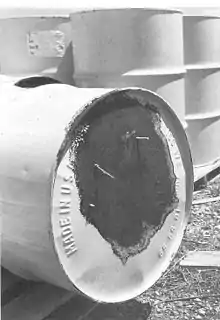Pondcrete
Pondcrete is a mixture of cement and sludge.[1] Its role is to immobilize hazardous waste and, in some cases, low-level and mixed-level radioactive waste, in the form of solid material.[2] The material was used by the United States Department of Energy and its contractor, Rockwell International, in an attempt to handle the radioactive waste from contaminated ponds in the Rocky Flats Plant for burial in Nevada desert.[3][4] Portland cement is mixed with sludge to solidify into “pondcrete” blocks and placed into large, plastic lined boxes.[5][6] The sludge is taken from solar evaporation ponds which are used to remove moisture from waste materials, therefore reducing their weight. To do this, liquid waste is poured into artificial, shallow ponds. The waste is heated by solar radiation and any moisture is evaporated, leaving behind the waste. These ponds contained low level radioactive process waste as well as sanitary sewage sludge and wastes,[7] which categorize them and the Pondcrete as a mixed waste.[8]



Radioactive waste
Because the blocks were classified as mixed-level radioactive waste, including plutonium, Rockwell International was unable to store the blocks in the Nevada Test site.[9][10][11] The Nevada Test Site did not have a permit to store mixed-level radioactive waste, so the blocks were left in temporary storage at Rocky Flats. Due to problems in production, many of the blocks did not harden correctly and eventually began to seep from the boxes causing large scale environmental contamination of the area.[12][13] The blocks containing plutonium-239, radioactive waste with a half-life of 24,100 years, had failed in a year. Despite warnings by engineer Jim Stone that the blocks would most likely fail earlier than expected, the blocks were still produced.[14] Later it would be Jim Stone who would file a lawsuit against the company, claiming that they had concealed environmental, safety and health problems from the United States Department of Energy.[15][16]
Investigation
The contaminations led to an investigation of the Plant by the Federal Bureau of Investigation and the Environmental Protection Agency which eventually resulted in its shutdown.[17] In 1993, Federal Judge Sherman Finesilver, approved the release of the Colorado Federal District Court Special Grand Jury Report on the investigation. The report found that the Department of Energy and the Environmental Protection Agency oversight were not performed adequately to protect the environment, and that Rockwell did not comply with environmental laws at the Rocky Flats Plant. The United States Department of Energy (DOE) and Rockwell violated the Resource Conservation and Recovery Act (RCRA) by illegally storing, treating and disposing of residues in more than 17,000 blocks of pondcrete and saltcrete in plastic lined cardboard containers outdoors on the 904 Pad at the plant. Each pondcrete block containing mixed-wastes (radioactive, cadmium, methylene chloride and acetone) weighed between 1,500 and 1,800 pounds. These blocks did not sufficiently harden like concrete, maintaining a consistency of wet clay. Many of the boxes ruptured, possibly due to extreme temperature fluctuations in that region of Colorado, spilling these wastes onto the asphalt pad at Site 904. Rain and wind carried these wastes into drainage areas and into the air and soil.[17]
See also
References
- Ketti, Donald (1993). Sharing Power: Public Governance and Private Marketing. Washington, CD: Brookings Institution Press. pp. 143–146.
- "Nuclear Health and Safety: Problems Continue for Rocky Flats Solar Pond Cleanup Program". Report to the Chairman, Environment, Energy, and Natural Resources Subcommittee, Committee on Government Operations, House of Representatives. United States Government Accountability Office, General Accounting Office. Retrieved 9 February 2014.
- Iverson, Kristen (2013). Full Body Burden: Growing Up in the Nuclear Shadow of Rocky Flats. Broadway Books. ISBN 978-0307955654.
- Garner, Dwight (September 27, 2012). "Growing Up in a Town of Weak Beer and Toxic Water: Book Review: Full Body Burden by Kristen Iversen". The New York Times. Retrieved 9 February 2014.
- Siegel, Barry (Aug 8, 1993). "Showdown at Rocky Flats: When Federal Agents Take on a Government Nuclear-Bomb Plant, Lines of Law and Politics Blur, and Moral Responsibility is Tested". Los Angeles Times. Retrieved 9 February 2014.
- Ackland, Len (2002). Making a real killing: Rocky Flats and the nuclear West. UNM Press, 2002. ISBN 978-0-8263-2798-7.
- "The Department of Energy's Rocky Flats Plant a Guide to Record Series Useful for Health-Related Research". Office of Health Safety and Security. Archived from the original on 15 May 2009. Retrieved 19 November 2009.
- Halliburton NUS Environmental Corporation. "Rocky Flats Plant Pondcrete/Saltcrete Remediation Program Description: "Pondcrete and Saltcrete White Paper"" (PDF). Department of Energy Legacy Management CERCLA Documents. DOE. Retrieved 19 June 2015.
- "The Rocky Flats Cover-up, Continued". Harpers Magazine. December 1992: 19. December 1992.
- Brever, Jacqueline (February 1992). "Inside Rocky Flats: A Whistleblower's Journal". Harpers Magazine. February 1992. Retrieved 9 February 2014.
- Calhoun, Patricia (August 8, 1996). "Grand Illusions". Denver Westword News. Retrieved 11 February 2014.
- Department of Energy, Office of Legacy Management. "Rocky Flats Site, Colorado: A CERCLA and/or RCRA Site". Energy.gov. Retrieved 9 February 2014.
- Kim Kinehear, Ken Heath. "Rockwell International Corp. v. United States (05-1272), Limtiaco v. Camacho (06-116) and order lis". Wiggin and Dana. Retrieved 7 November 2009.
- Associated Press (2 April 1999). "Rocky Flats whistleblower wins suit against Rockwell". Amarillo Globe News. Archived from the original on 27 February 2014. Retrieved 9 February 2014.
- Times Staff and Wire Reports (April 16, 2007). "James Stone, 82, filed whistle-blower lawsuit against weapons firm". Los Angeles Times. Retrieved 9 February 2014.
- "Carved in Stone" (PDF). westword. Retrieved 2 December 2009.
- "Colorado Federal District Court Report of the Federal District Special Grand Jury 89-2". January 24, 1992. Constitution.org. Archived from the original on 7 January 2016. Retrieved 12 February 2018.
{{cite web}}: CS1 maint: bot: original URL status unknown (link)